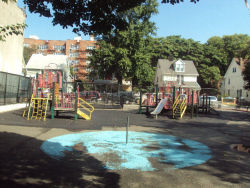Winthrop Playground
Parkside Playground
This playground and the nearby avenue take their names from the 1902 dedication of Fort Hamilton Parkway, between New York and Coney Island Avenues, as Parkside Avenue. This renaming honored the avenue’s new “park side” location, the park being Brooklyn’s Prospect Park.
Prospect Park was conceived in the 1860s, after decades of massive population growth erased Brooklyn’s rolling countryside. In 1859, the New York State Legislature, at the request of the City of Brooklyn, authorized the city to select sites for public parks. This act included a site first called Mount Prospect Park. The following year, the Prospect Park Commission was established, with James S.T. Stranahan (1808–1898) as its president. The park’s design was created by Frederick Law Olmsted (1822–1903) and Calvert Vaux (1824–1895), who are perhaps better known for designing Manhattan’s Central Park. Work on the new park was first delayed by the outbreak of the Civil War (1861-1864), and then again after the park was nearly completed in 1873, when an economic recession hit and several parts remained unfinished until after 1885.
Prospect Lefferts Gardens neighborhood’s three-word name was adopted in 1969, combining three elements of its history and environs: neighboring Prospect Park, the Lefferts Homestead property, on which the neighborhood was built, and the nearby Brooklyn Botanic Garden. In the 1670s, Dutch settler Leffert Pietersen van Haughwout (1650-1704) established a farm on the land in this area. In the 1780s, descendant Peter Lefferts (1753-1791), a lieutenant in the Continental Army and delegate to the Constitutional Convention, built a Dutch-style farmhouse on this land. The farmhouse, originally located at Flatbush Avenue and Maple Street, was presented to the City by Lefferts’s descendents in 1918. The entire house was moved to Prospect Park for preservation. One of the oldest buildings in Brooklyn, it functions as a historical museum with programs and exhibits that reflect daily life in colonial times.
In the 1890s, after the completion of Prospect Park, James Lefferts (1856-1915) sold the land to develop row houses, some of which still stand in the neighborhood. Parkside Avenue features wrought iron lanterns from the beginning of the 20th century when the neighborhood was still being built.
Parkside Playground, which adjoins P.S. 92, opened in 1956 and is jointly operated by Parks and the Board of Education. The school and playground are situated on the eastern portion of Parkside Avenue, between Rogers and Bedford Avenues. The playground features basketball and handball courts, a public restroom, play equipment, and a flagpole with a yardarm. In 1997, Mayor Giuliani funded a $35,000 renovation of the handball walls, court pavements, and park fences.
Check out your park's Vital Signs
Clean & Safe
Green & Resilient
Empowered & Engaged Users
Share your feedback or learn more about how this park is part of a
Vital Park System

